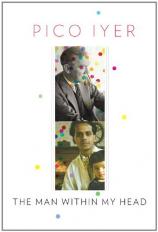The Man Within My Head
Review
The Man Within My Head
The British writer Graham Greene died in 1991, and now, some 20 years later, novelist and journalist Pico Iyer has written a thoughtful and impressionistic appreciation of Greene’s life and work, tying it in intriguing ways to his own life story in what he describes as a “counterbiography.”
"Pico Iyer’s book is more than a fascinating literary study of an admired author. Through its lucid insights, it shows us how engagement with literature can create a reality somehow more real than life itself."
Iyer’s life has been as peripatetic as Greene’s, and on the surface that would seem to provide a ready explanation of his affinity for Greene’s work. Born in England to parents of Indian heritage, Iyer moved when he was eight years old to California, where his philosopher father took a position with the now-defunct Center for the Study of Democratic Institutions. Despite the transatlantic move, Iyer was educated in British public schools and graduated from Oxford. He is married to a Japanese woman and resides in Tokyo. Like Greene, Iyer is a true citizen of the planet with connections everywhere and real roots seemingly nowhere.
Greene’s biographer, Norman Sherry, has produced a three-volume (more than 2,200 pages) account of his life, a work to which Iyer has acknowledged a considerable debt. Some of the more salient aspects of Greene’s story --- his association with Britain’s MI6 (where he befriended the Soviet spy Kim Philby), his numerous affairs and his perpetual restlessness --- are probably known to those even casually familiar with his biography. Iyer doesn't strive for a small-scale replica of Sherry’s monumental work here; instead, as he recounts in a conversation with a writer friend, he’s more interested in uncovering “the things that lived inside him. His terrors and obsessions. Not the life, as it were, but what it touched off in the rest of us.”
Iyer’s connection with Greene’s novels like THE QUIET AMERICAN, THE COMEDIANS and THE END OF THE AFFAIR is intense and intimate. While creating an inviting passageway into his subject’s work, at least some of his commentary will be more meaningful to those familiar with Greene’s writing, even if it’s only through the numerous film versions of his novels, starring actors like Michael Caine and Ralph Fiennes. Throughout, Iyer marvels at the mysterious way a “scruffy mongrel living in Japan can feel that his deepest life story is being told by an Englishman of two generations before.”
He moves from what he calls “trivial” if interesting “correspondences” between his experiences and Greene’s life and stories --- from the parallels in their schooling to chance meetings Iyer had in places like Vietnam, Cuba or Bolivia with people who might have been lifted from a Greene novel --- to more fundamental engagement with the elder man’s worldview. Greene becomes much more than an indirect mentor or literary idol to the younger writer. Instead, his life and work literally insinuate themselves into Iyer’s very being, even his dreams.
As much as anything, Greene’s struggles with faith are a central concern of this book. Though his subject is sometimes characterized as a “Catholic novelist,” Iyer is more interested in highlighting the deep doubts and tensions that marked Greene’s thinking about religion, “a spirited argument with God,” as he describes it. In novels like THE POWER AND THE GLORY, the story of a troubled Mexican priest, Greene “would always, with precise perversity, come at faith through the back door, not by way of the man of principle or pure saint, but through the confused bungler who inspires our pity and perhaps even our love with his fallenness.” Though Iyer writes movingly of his periodic visits to a California monastery, he’s almost purposefully vague on the subject of his own religious beliefs or practices, leaving the clear impression of sympathy with Greene’s spiritual travails.
“The paradox of reading,” Iyer observes, “is that you draw closer to some other creature’s voice within you than to the people who surround you (with their surfaces) every day.” That paradox leads to the tension at the heart of this book, never fully resolved. It lies in Iyer’s exploration of his affectionate, if somewhat distant relationship with his own father and its contrast with his deep engagement with Greene’s world. Ultimately, Greene becomes, for Iyer, his “chosen” or “adopted” father, one who “can never die” (as Iyer’s did in 1995) and “never grows old, or loses his memory. He’s always there for you.” Greene “knew me better than I did myself,” Iyer concedes. And in a similar way, through his writing, Greene exposed “his secrets, his sins, his most intimate needs,” and thus enabled at least this one reader to know him more deeply than he knew his own parent.
Thus Pico Iyer’s book is more than a fascinating literary study of an admired author. Through its lucid insights, it shows us how engagement with literature can create a reality somehow more real than life itself.
Reviewed by Harvey Freedenberg on January 19, 2012
The Man Within My Head
- Publication Date: January 3, 2012
- Genres: Nonfiction
- Hardcover: 256 pages
- Publisher: Knopf
- ISBN-10: 030726761X
- ISBN-13: 9780307267610




